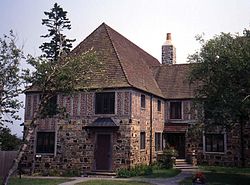History
In the early 1930s, Otter Cliffs Radio Station on Mount Desert Island was literally falling apart. [1] John D. Rockefeller Jr., then developing the infrastructure of Acadia National Park, sought to locate the park's main loop road through the Otter Cliffs area. [2] The Navy was willing to meet Rockefeller halfway on the removal of the radio station from Otter Cliffs, agreeing to relocate if a suitable site could be found on the coast within 50 miles (80 km) of Otter Cliffs. [1] Big Moose Island, at the tip of Schoodic Peninsula about 5 miles (8.0 km) across the mouth of Frenchman Bay from Otter Cliffs, was determined to be an ideal location for the relocated radio station, and agreement was reached between the Navy, Interior Department, and Rockefeller for the relocation. [2]
Rockefeller, wishing the station's buildings to be compatible with others designed for the park, retained Grosvenor Atterbury, the New York architect who designed the park's gatehouses, to come up with plans for the radio station. Atterbury's plan for the new station included a beautiful residence hall similar to Mr. Rockefeller's residence at Seal Harbor. Artisans from all over the world contributed to the project. This building, and the adjacent power station which was also designed by Atterbury, were listed on the National Register of Historic Places in 2013. [2]
On 28 February 1935, the U.S. Navy Radio and Direction Finding Station Winter Harbor was officially commissioned with Chief Radioman Max Gunn in charge of a complement of an 11 personnel crew. [1]
The station's name has changed several times over the years. In 1944, it was changed to Supplementary Radio Station, U.S. Naval Radio Station Winter Harbor. In 1950, it became known as U.S. Naval Radio Station (Receiver). The present station name, Naval Security Group Activity, Winter Harbor, became official on 9 June 1958.
In 2001, the base transitioned from an operational posture to focusing on the closure process, with the ultimate goal of transferring the Schoodic parcel to the National Park Service. The last System Maintenance Training Course graduated in July 2001. The AN/FRD-10 Wullenweber Antenna and Classic Wizard antennas came down in August. The last service was held at the Chapel 2 September 2001, and the Foc'sle Galley served its last meal on 28 September 2001. [1]
This page is based on this
Wikipedia article Text is available under the
CC BY-SA 4.0 license; additional terms may apply.
Images, videos and audio are available under their respective licenses.




